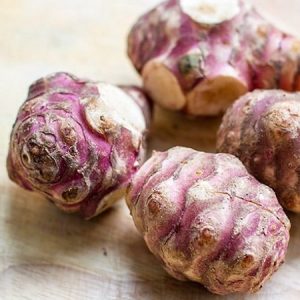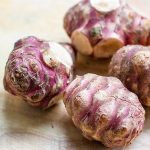We use cookies to make your experience better. To comply with the new e-Privacy directive, we need to ask for your consent to set the cookies. Learn more.
Jerusalem Artichokes

Not hailing from Jerusalem, nor an artichoke, but a species of sunflower which produces masses of edible tubers. Jerusalem Artichokes originated in North America and were introduced to Europe by colonists.
Growing Jerusalem Artichokes Jerusalem Artichokes are very easy to grow but some things are worth considering -
- They are large plants which can be between 1.5-3m high so be careful not to put them where they will shade out other crops.
- From April, plant into well-prepared soil at a depth of 10-15cm with tubers spaced 30cm apart. Row spacing 1m.
- When stems are around 30cm tall, draw soil around them to a depth of 20cm to help stabilise plants as they grow.
- You can cut back stems (including flowerheads) to around 1.5m in midsummer so plants won’t be rocked by the wind, thus avoiding the need for staking.
- When foliage starts to turn yellow in autumn, prune to leave 10cm stumps above ground level. Place the prunings over plants to keep the soil warm and aid lifting of tubers in frosty weather.
- Can be left in the soil and harvested as needed. If you have heavy wet soil it is best to lift and store them.
Harvesting Harvest the tubers as required with a garden fork from late autumn into winter. Jerusalem artichokes are persistent, so if you don’t want them coming back the following year, make sure you remove every last one - tubers left in the ground will regrow into a large plant the following spring. Harvested early they taste earthy. If left in the ground longer and exposed to the cold winter months they become sweeter.
Eating
- You can cook Jerusalem artichokes peeled or unpeeled. Scrub them with a stiff brush just before you cook them. Sorting your tubers by size will simplify preparation.
- Medium-sized Jerusalem artichokes that have numerous bumps and knobs can be boiled whole in their skins and then mashed and sieved to form the basis for Jerusalem artichoke soup, which many say is the best way to eat the veggie.
- Rather than struggling to peel small, knobby tubers, scrub them well and then roast them with a little olive oil and sea salt. After they’ve cooled, eat them as finger food by squeezing the soft middle into your mouth - a North American food practice that dates back more than 1,000 years!
- Jerusalem artichokes get their sweetness from a unique sugar called inulin, which the body metabolizes much more slowly than it does other sugars. This makes the veggie a preferred food for diabetics, and for anyone who wants to avoid eating simple sugars and starches.

